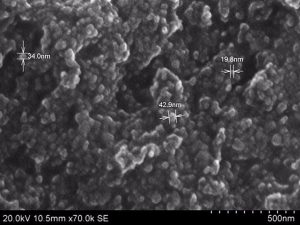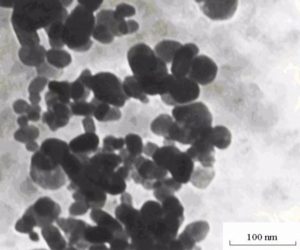New generation of nanoparticles lubricants for refrigeration systems
The Coefficient of Performance (COP) of a refrigerating system is defined as the ratio between the cooling effect and the compression work, as given by:

The previous equation implies that the COP can be improved either if the cooling effect increases or if the compression work decreases or if both events happen contemporary. The increasing of the cooling effect can be achieved by means of several different techniques, which have been developed and proposed in last decades. Many research efforts have also been dedicated to design more and more efficient compressors.
The application of nanofluids in refrigerating systems is considered to be a potential way to improve the energy efficiency and reliability of HVAC&R facilities and to make economic the use of environment-friendly refrigerants.
Recently, some researchers have proposed to introduce new nano-refrigeration oil formed by blending some nanoparticles (NiFe2O4, TiO2, Al2O3) into mineral oils. For instance, Bi et al. (2008) proposed to substitute the Polyol-ester (POE) oil with a mineral oil with TiO2 nanoparticles mixtures in a R134a refrigerator. The authors analysed the compatibility of non-metallic materials in the system with the R134a and mineral oil–nanoparticles mixtures. The refrigerator performance with the nanoparticles was then investigated using energy consumption tests and freeze capacity tests. The refrigerator prototype had a gross capacity of 265 L and it was a double-door, double-temperature, double-controlled system, which used a reciprocating compressor.
The energy consumptions of the system were measured in several configurations: R134a/POE oil (reference), R134a/mineral oil-TiO2 nanoparticles with two different mass fractions, 0.06% and 0.1%. The next Table lists the most important results.
The results found by Bi et al. (2008) demonstrate the interesting improvements that can be achieved by the implementation of a small amount of nanoparticles inside the lubricant oil. The reduction of the energy consumption can be around the 26%. The authors also investigated the effects of the nanoparticles properties on the refrigerator performance by adding the same amounts of Al2O3 to the mineral oil.
As reported in the previous Table, the refrigerator performance seems to be weakly affected by the nature of the nanoparticles mixed with the mineral oil; tests with R134a/mineral oil showed considerable energy saving, around 16.7%, by using just the mineral oil without the nanoparticles. However, the use of the nanoparticles can permit to achieve up to 26% of energy saving; furthermore, nanoparticles also enhance the solubility of R134a in mineral oil and the oil return ratio of the compressor.
More recently, Sabareesh et al. (2012) have experimentally investigated the application of TiO2 nanoparticles as a lubricant-additive for vapour compression refrigeration systems.
Figure 1: SEM image of TiO2 nanoparticles. (Sabareesh et al., 2012)
Figure 1 shows a SEM image of the nanoparticles that were mixed with mineral oil and then implemented as lubricant in a R12 refrigeration system. The use of CFC R12 refrigerant represents the weak point of this work; however, the results obtained by the authors deserve to be presented because permit to highlight the interesting capabilities of this new-generation of nano-lubricants.
A 0.01% volume fraction of TiO2 was added to mineral oil to obtain a new lubricant; the next Table reports the experimental results measured for a small refrigeration unit tested by the authors.
From data listed in Table, it clearly appears that 0.01% volume fraction increased the average cooling capacity by about 3.6% and reduced the power input by about the 11%; as a result, the COP of the machine was increased by about 17%.
Another interesting work (Wang et al., 2010) regards the use of a new mineral-based nano-refrigeration oil, formed by blending some nanoparticles (NiFe2O4) into naphthene based oil B32 in a R410A residential air conditioner. The authors also performed solubility analyses of this new nano-lubricant in R134a, R407C, R410A, and R425a.
Figure 2: TEM image of NiFe2O4 nanoparticles. (Wang et al., 2010)
The performance tests of the residential air conditioner were run in a humidity controlled chamber; the results showed that the nanoparticles mineral oil seems to be stable enough to be employed as lubricant in residential air conditioning systems. The solubility of this new nanoparticle lubricant in the most common HFC refrigerants was also good enough for the application.
The results indicated that the mixture R410A/NiFe2O4-mineral oil works properly in the air conditioning system and the performance of the prototype was significantly greater (4-6%) than that used R410A/POE, whether operated in cooling or heating conditions.
Finally, Wang et al. (2010) demonstrated the feasibility of using the new nanoparticles mineral oil to substitute the POE oil when retrofitting R22 with R410A in residential air conditioning.
From this brief overview, it clearly appears that there is a great interest in the research community focused on this new generation of lubricants that uses nanoparticles to improve the solubility in refrigerants of the traditional oils and the energy savings of the whole refrigerating machine.
References
- S.-S. Bi, L. Shi, L.-L. Zhang, Application of nanoparticles in domestic refrigerators, Applied Thermal Engineering, 2008, 28: 1834-1843.
- R.K. Sabareesh, N. Gobinath, V. Sajith, S. Das, C.B. Sobhan, Application of TiO2 nanoparticles as a lubricant-additive for vapour compression refrigeration systems – An experimental investigation, International Journal of Refrigeration, 2012, 35: 1989-1996.
- R. Wang, Q. Wu, Y. Wu, Use of nanoparticles to make mineral oil lubricants feasible for use in a residential air conditioner employing hydrofluorocarbons refrigerants, Energy and Buildings, 2010, 41: 2111-2117.
Related topics
- What are nanofluids and which are their applications?












